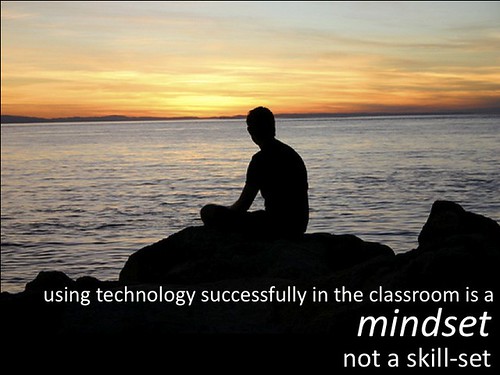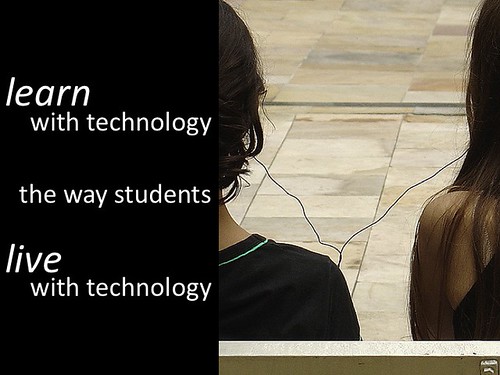Apparently I am embarking on a very modest consulting career.
Last year, Julie Lindsay invited me to spend 2 days at her school, Qatar Academy, working with the Primary School teachers on 21st century learning. Amazingly, that visit went so well that she invited me back again this year, this time to work with the Senior School (middle and high school) teachers on the same topic. I was truly flattered to be asked back and have really enjoyed the experience.
I never would have expected when I started teaching that anyone would invite me to their school to work with their teachers, but now that I’ve had the chance, I know I would like to continue building these skills.
One of the things I really enjoy about these visits is the opportunity to really consolidate my thinking. Every time I make a presentation I take the time to really clarify what I need to say, what background needs to be covered for it to make sense, and why it’s important to teaching and learning. This time around a few topics from the three presentations I gave jumped to the surface:
Using technology in the classroom is a mindset, not a skill-set.
This is something I’ve been saying for a long time, but I feel like it’s becoming more and more important as technology continues to change more and more rapidly. The feeling of being overwhelmed by new information, of not being able to catch up, of needing to know more than your students, can end up leading teachers down a path of avoidance instead of adoption. Focusing on the attitudes and mindset of a teacher who successfully uses technology in the classroom helps make the shift more approachable.
Teachers who use technology in the classroom are: flexible, willing to take risks and try new things, not afraid of failing, able to learn from their students, adaptable, and comfortable with the fact that they are not the smartest person in the room. Cultivating this kind of mindset is the first step to understanding how to use technology successfully in the classroom.
Unfortunately, this is also a paradigm shift for many teachers. What do you mean I’m not the smartest person in the room? Isn’t that why I’m the teacher and they’re the student? Which brings me to the next key point:
It’s not about the technology, it’s about the pedagogy.
It’s so easy to focus on the tools. Teachers are very comfortable being shown the power of a new tool and figuring out how they can make it work for their teaching style. It seems like the “how to” is what most teachers like to hear, see and test first. Unfortunately, it’s just too easy to make the tools fit the old paradigm. If we’re not talking about pedagogy, if we’re not talking about changing the classroom environment, if we’re not talking about students learning how to learn, there’s really no point to talking about the tools.
In the end we all want our students to be successful, but there are certain pedagogical approaches that will help them become independent learners, who can survive and thrive in the constantly changing, media rich, content saturated world we live in. Classrooms that are project based, inquiry driven, and student centered not only help us reach our goals as teachers, but they also very naturally lend themselves to successful technology integration. If a teacher is using the same worksheets s/he has used for 10 years, or teaching one individual lesson one day after the next, or leads an activity-based classroom, it’s going to be awfully hard to authentically embed technology into that environment. No matter how easy and quick it might be to look at the tools first, we have to start with the pedagogy and the “why.”
We need to learn with technology the way students live with technology.
In the end, this is about making school relevant. We may not like the changes in our society, we may not appreciate the constant media bombardment of our children that ends up in something like this (which, personally I find rather horrifying), but the reality is, this is our world. We made it this way. Now we have to find ways to ensure that our children learn how to live in this world, how to stay safe, how to lead balanced lives, how to use all of these many tools at their disposal for appropriate and authentic purposes. We can’t do that by ignoring technology. We also can’t do that by making those tools fit our preferred style of learning. We have to tap into the energy our students bring to class to find ways to learn with technology the way students live with technology.
This is not an all-or-nothing proposition. It’s about finding ways to authentically use the appropriate, relevant and pedagogically sound tools to enhance the learning experience for our students. It doesn’t mean all the time, but it does mean in different ways that we might be used to. I love Marc Prensky’s statement about doing new things in new ways. This is what we’re looking for. No need to retro-fit a new tool to an old project. How can we get to our curricular goals in a new way, in a way that engages our students? As Chrissy likes to say: we’re still going to the same place, we just might need to drive a different vehicle.
Conversation Starter
In the end, these visits are about starting conversations, promoting new thinking and questioning just about everything. Everything is not going to be resolved in a two- or three- or even ten-day visit. All we can hope to accomplish is to get people talking, to stir up the pot a bit, to snap some out of their comfort zones and to promote the work of others, to bring in relevant information from the “outside world” and to kick start the change process.
The absolute best thing about my visit this time around was having the chance to talk to some of the Primary School teachers I worked with last year. Every single one of them said to me: “You changed me.” Wow. I’ve never, ever had anyone say that to me before. To be able to come in for a short visit, share some new ideas, help inspire and empower people, and then to hear about your success from those very people only a year later. Yes, that is definitely something I would like to do more often.
Now, this is not to say that everything went perfectly during both visits. There are challenges, problems, disagreements and, to be honest, a little bit of anger and fear, all to be expected. But in the end it’s those conversations that get things started. And, as we all know, there’s always room to grow. A few things I want to think about well in advance next time around are:
- What has been the school’s history with technology (or any other) initiates?
- What is the general feeling of the staff? Are there members who are supportive? Those who will challenge anything?
- What success can we share from the school itself? How can we promote success internally?
- Where are the administrators? How visible will they be during the visit?
- What are the practical issues specifically relevant to the school, student body, parent population and culture?
- What is the culture of the school in general?
As usual, everything is a learning experience. Anyone have any other advice about consulting?








Kim, I’ve watched your progress through your blog and tweets. It’s obvious you do great work which is of great value to other educators. I’m totally happy for you and your training opportunities. I hope someday I get to do the same. But first I’d like to work overseas at a school like yours or Julie Lindsay’s. :)
You’re a great role model. Enjoy your success!
In a district where our technology grant required taking three courses to have these discussions, I am amazed at the resistance still in your basic principles above. Have you been into schools where the vast majority were not buying into the shift in pedagogy? Do they see this as an old reform just packaged in a new way?
I love how you’ve framed these mindsets — I think they really highlight the best way to make technology an enhancer for all types of learning. And congratulations on teaching the grad course, it sounds so interesting — I’d love to learn more about it, even though I’m not a teacher :)
Thank you. It is rare to see meet someone who understands that
@Suzanne,
Thank you! You should definitely think about teaching overseas! It’s a great experience both professionally and personally. Have you looked into the recruitment fairs yet?
@Louise,
I think there are a few factors at work in schools all around the world. I would say the biggest obstacle I have faced is fear (of not knowing, not being able to keep up, of looking “stupid” in front of the kids) both from teachers, admin and parents in every school I’ve worked in or visited. Beyond that there are also issues with higher level teachers modeling themselves after university professors (which is unfortunate because university professors get hired for their publishing and research not their teaching), which is exacerbated by the IB Diploma requirements. Of course we also have the problem of lack of equipment, time, personnel support, admin support, etc. Honestly, I think all schools are going through the same thing…. And it seems like each school is determined to find their own way through, instead of working together to solve these bigger issues.
@Zoe,
Thanks! I’m glad the idea of enhancing the learning comes through – there was a lot of discussion about technology being “all or nothing” which is absolutely not the case. We’re looking for blended learning that authentically uses the tools to enhance the learning process.
@Matthew,
Thanks! Looks like the html was wrong in your comment so I’m going to include the quote here:
“Classrooms that are project based, inquiry driven, and student centered not only help us reach our goals as teachers, but they also very naturally lend themselves to successful technology integration.”
And, the link, for others if they’re interested: http://www.techsmith.com/community/education/newsletter/edunews082008.asp#art3